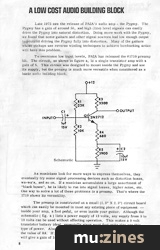Magazine Archive
Home -> Magazines -> Issues -> Articles in this issue -> View
A Low Cost Audio Building Block | |
Article from Polyphony, February 1976 | |
Late 1975 saw the release of PAIA's audio amp - the Pygmy. The Pygmy has a gain of around 50, and high (line) level signals can easily drive the Pygmy into natural distortion. Doing more work with the Pygmy, we found that some guitars and other signal sources had low enough output to prohibit driving the Pygmy fully into distortion. Many of the guitars whose pickups use reverse winding techniques to achieve humbucking action will have this problem.
To overcome low input levels, PAIA has released the #1710 preamp kit. The circuit, as shown in figure a, is a single transistor amp with a gain of 5. This circuit was designed to mount inside the Pygmy and use its supply, but the preamp is much more versatile when considered as a basic audio building block.

As musicians look for more ways to express themselves, they eventually try some signal processing devices such as distortion boxes, wa-wa's, and so on. If a musician accumulates a large assortment of "black boxes", he is likely to run into signal losses, higher noise, etc. One way to solve a lot of these problems is a preamp. That's where the 1710 shows its versatility.
The preamp is constructed on a small (1.5" X 2.5") circuit board which can easily be mounted in most any existing piece of equipment — inside your amp, a foot pedal, or even inside your guitar. Although the schematic (fig. a) lists a power supply of 12 volts, any supply from 9 to 18 volts can be used without affecting operation. This makes a 9 volt transistor battery ideal, especially since most foot units also use this type of power. Also, the gain of the preamp can be changed by varying the value of R4. If you need more gain, decrease R4 to 330 ohms. This will give a gain of 10.
The AC input impedance of the preamp is around 7K ohms. The output is approximately 500 ohms. No output capacitor is used on the 1710 since the Pygmy amp input is AC coupled. For experimentation in other applications, an output capacitance of at least .1 mfd. should be used.
If this unit looks interesting to you as an experimental building block, or as a functional item to be added to your present equipment, the complete kit including circuit board, parts and instructions is available from PAIA by ordering kit #1710 for $1.50 postpaid.
Happy experimenting!
More with this topic
Chip Parade (Part 1) |
How To Make An EGG Mod |
Digital Signal Processing (Part 1) |
Circuit Maker - Digital Equipment Protector |
PA Signal Processor (Part 1) |
Guitar Routing Box (Part 1) |
 Confessions - ...of an English kit builder. |
Augmenting the 3750's Memory |
Adventures with Op-Amps |
4780 Sequencer Modification |
Magic Buttons - Touch Switch Theory |
VCO |
Browse by Topic:
Electronics / Build
Publisher: Polyphony - Polyphony Publishing Company
The current copyright owner/s of this content may differ from the originally published copyright notice.
More details on copyright ownership...
Feature by Marvin Jones
Help Support The Things You Love
mu:zines is the result of thousands of hours of effort, and will require many thousands more going forward to reach our goals of getting all this content online.
If you value this resource, you can support this project - it really helps!
Donations for April 2024
Issues donated this month: 0
New issues that have been donated or scanned for us this month.
Funds donated this month: £7.00
All donations and support are gratefully appreciated - thank you.
Magazines Needed - Can You Help?
Do you have any of these magazine issues?
If so, and you can donate, lend or scan them to help complete our archive, please get in touch via the Contribute page - thanks!













